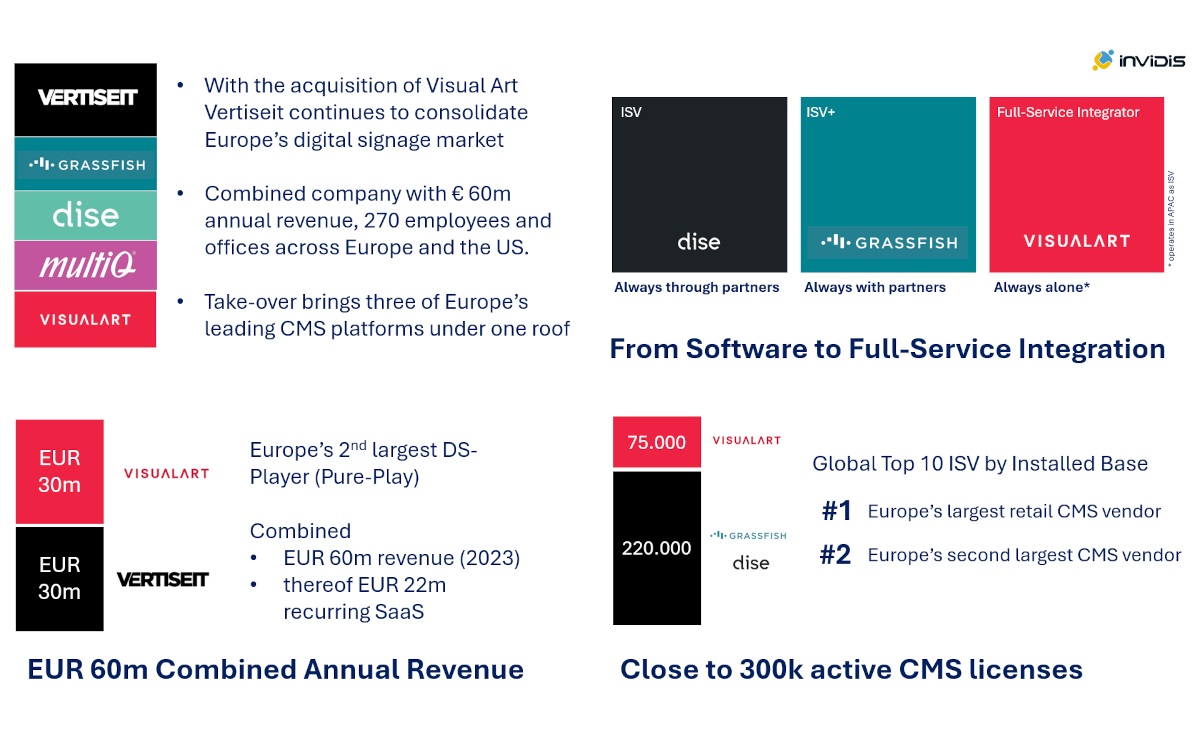The Swedish digital signage provider is seizing another consolidation opportunity in Europe and is taking over Visual Art, one of the best-known European integrators based in Stockholm. With the acquisition, Vertiseit CEO Johan Lind is expanding its digital signage offering to include a full-service integrator with a state-of-the-art CMS platform, a content studio,and concept teams.

Vertiseit: Disruption by Design
Visual Art was up for sale after Ocean Outdoor and founders wanted to pull out. Under discussion was an IPO or a sale to strategic and/or financial investors. Many of the larger European digital signage providers showed interest in a takeover. But as is so often the case in Scandinavia, in the end it is Vertiseit who wins. The well-connected, listed digital signage provider from a small city near Gothenburg won the race for Visual Art and is taking over the integrator with its European and US subsidiaries.
Vertiseit’s CEO Johan Lind has been actively consolidating – particularly in Scandinavia – the digital signage industry for over 10 years. With its eighth takeover, the digital signage provider, founded in 2005, has grown from a small Swedish software developer to a globally leading retail experience platform provider. In Europe, Vertiseit had become widely known after the takeover of Grassfish in 2021. Since then, Vertiseit added MultiQ (Malmö) and now Visual Art.
Wanderer between the worlds
Vertiseit sees itself neither as a pure-play independent software provider (ISV) nor as an integrator. With Grassfish, Vertiseit is active on the market as a retail experience platform provider plus concept and integration (ISV+), independent digital signage integrators are served with Vertiseit’s Dise software platform. With the takeover of Visual Art, Vertiseit is now expanding its offering to include a full-service integrator with a leading CMS platform, content studio, and retail media business.
For some Vertiseit customers, the Visual Art takeover could be interpreted as crossing a red line. Vertiseit’s newly extended integration offering with Visual Art – considered one of the best in Europe – puts Vertiseit in direct competition with Dise integration partners. An integrator dilemma already known from Stratacache/Scala, where the trustful software supplier also turned into a direct competitor.
Vertiseit CEO Johan Lind is certainly aware of the possible conflicts of interest and will work hard to convince all partners of the mutual benefits of the takeover. But the truth is also that such perceived boundary crossings will happen more frequently in the industry in the future. Tectonic shifts in the value chain, the customers’ desire for large global platforms, and the rapidly changing role of software can only be addressed through consolidation. The digital signage industry is growing up and disruptors like Johan Lind don’t want to be left behind and rather actively shape the industry.
Focus on recurring revenue
Anyone who met CEO Johan Lind knows about his laser-sharp focus on SaaS and ARR revenues. The opportunity to take over Visual Art was too good to leave it to the competition. For just around 40 million euros, Vertiseit was able to take over the Swedish integrator with an excellent software platform generating more than 6.5 million euros in SaaS revenue (ARR) annually. With the takeover, Vertiseit is increasing its SaaS (ARR) revenue from around 15 million euros to 22 million euros. Another step on Vertiseit’s ambitious medium-term goal to one billion SEK in ARR revenue – the equivalent of 88 million euros.
Vertiseit finances the Visual Art acquisition with a combination of bank loans and newly issued shares. Part of the transaction is also the entry of Bonnier Capital, which will become Vertiseit’s largest shareholder with 18%, ahead of CEO and founder Johan Lind, who until now held 8% of the company’s shares. Bonner Capital is the investment arm of Scandinavia’s largest publishing house, Bonnier.
